(Doc) Global Business Environment Assignment Solution
VerifiedAdded on 2021/01/02
|7
|2107
|68
AI Summary
Contribute Materials
Your contribution can guide someone’s learning journey. Share your
documents today.
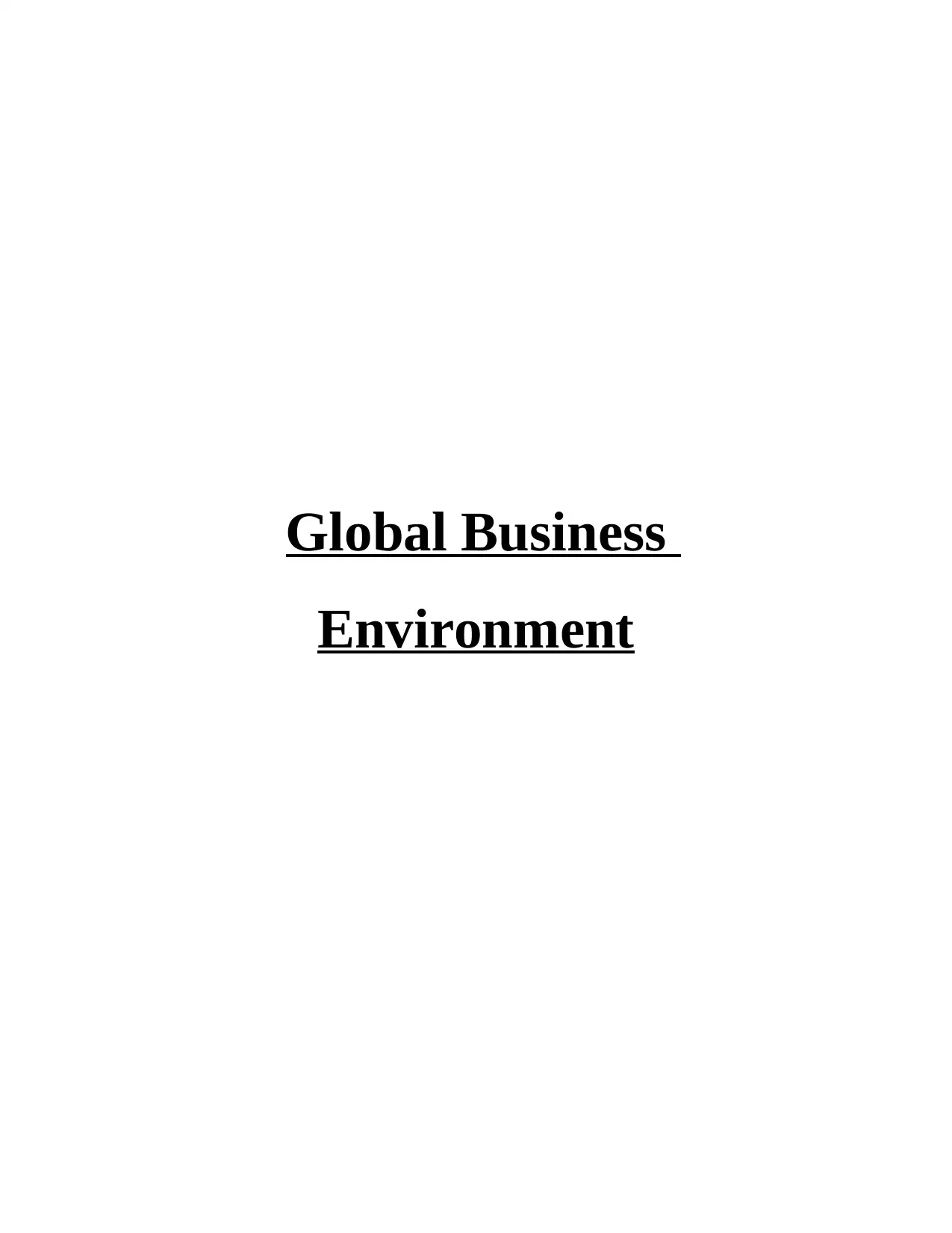
Global Business
Environment
Environment
Secure Best Marks with AI Grader
Need help grading? Try our AI Grader for instant feedback on your assignments.
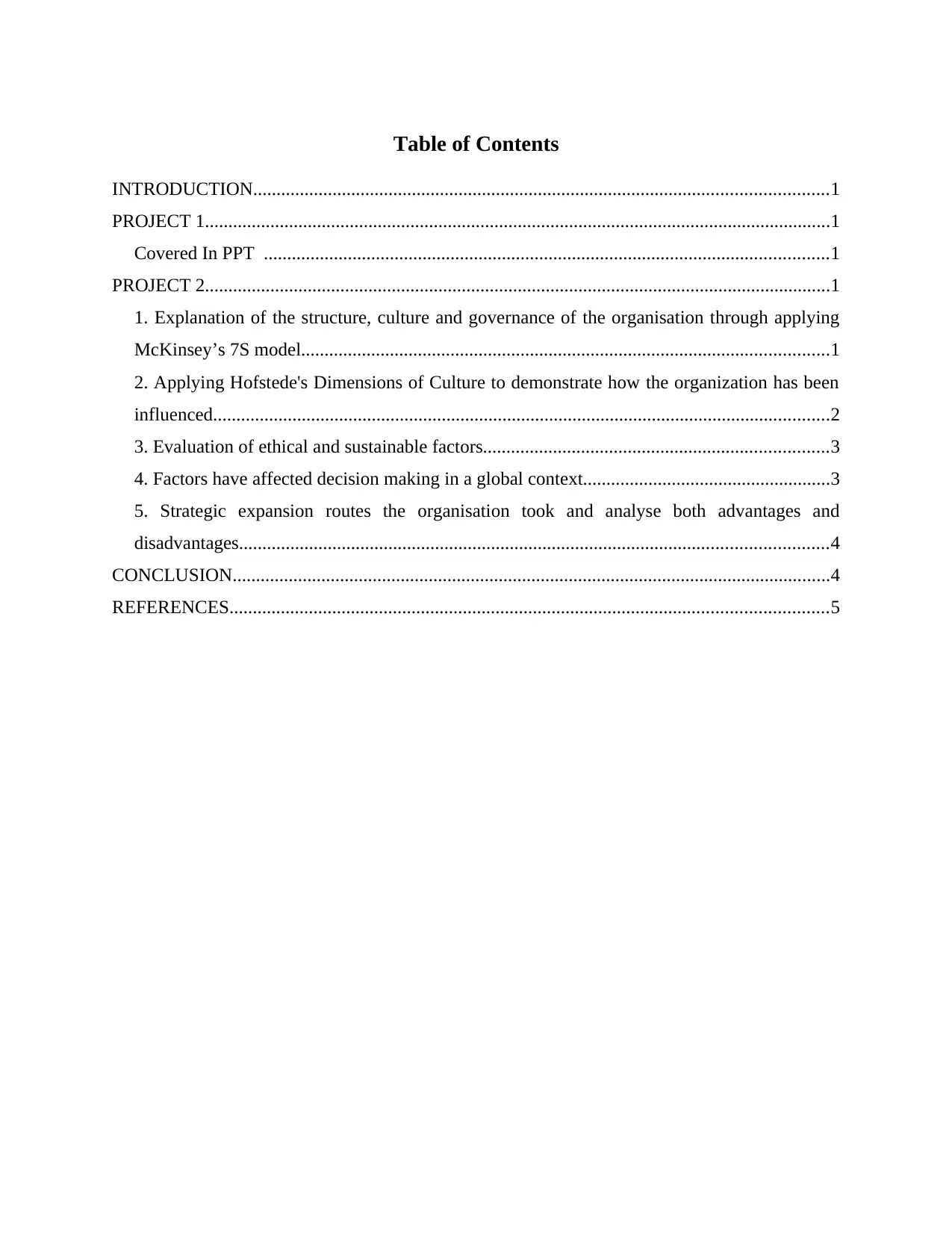
Table of Contents
INTRODUCTION...........................................................................................................................1
PROJECT 1......................................................................................................................................1
Covered In PPT .........................................................................................................................1
PROJECT 2......................................................................................................................................1
1. Explanation of the structure, culture and governance of the organisation through applying
McKinsey’s 7S model.................................................................................................................1
2. Applying Hofstede's Dimensions of Culture to demonstrate how the organization has been
influenced....................................................................................................................................2
3. Evaluation of ethical and sustainable factors..........................................................................3
4. Factors have affected decision making in a global context.....................................................3
5. Strategic expansion routes the organisation took and analyse both advantages and
disadvantages..............................................................................................................................4
CONCLUSION................................................................................................................................4
REFERENCES................................................................................................................................5
INTRODUCTION...........................................................................................................................1
PROJECT 1......................................................................................................................................1
Covered In PPT .........................................................................................................................1
PROJECT 2......................................................................................................................................1
1. Explanation of the structure, culture and governance of the organisation through applying
McKinsey’s 7S model.................................................................................................................1
2. Applying Hofstede's Dimensions of Culture to demonstrate how the organization has been
influenced....................................................................................................................................2
3. Evaluation of ethical and sustainable factors..........................................................................3
4. Factors have affected decision making in a global context.....................................................3
5. Strategic expansion routes the organisation took and analyse both advantages and
disadvantages..............................................................................................................................4
CONCLUSION................................................................................................................................4
REFERENCES................................................................................................................................5
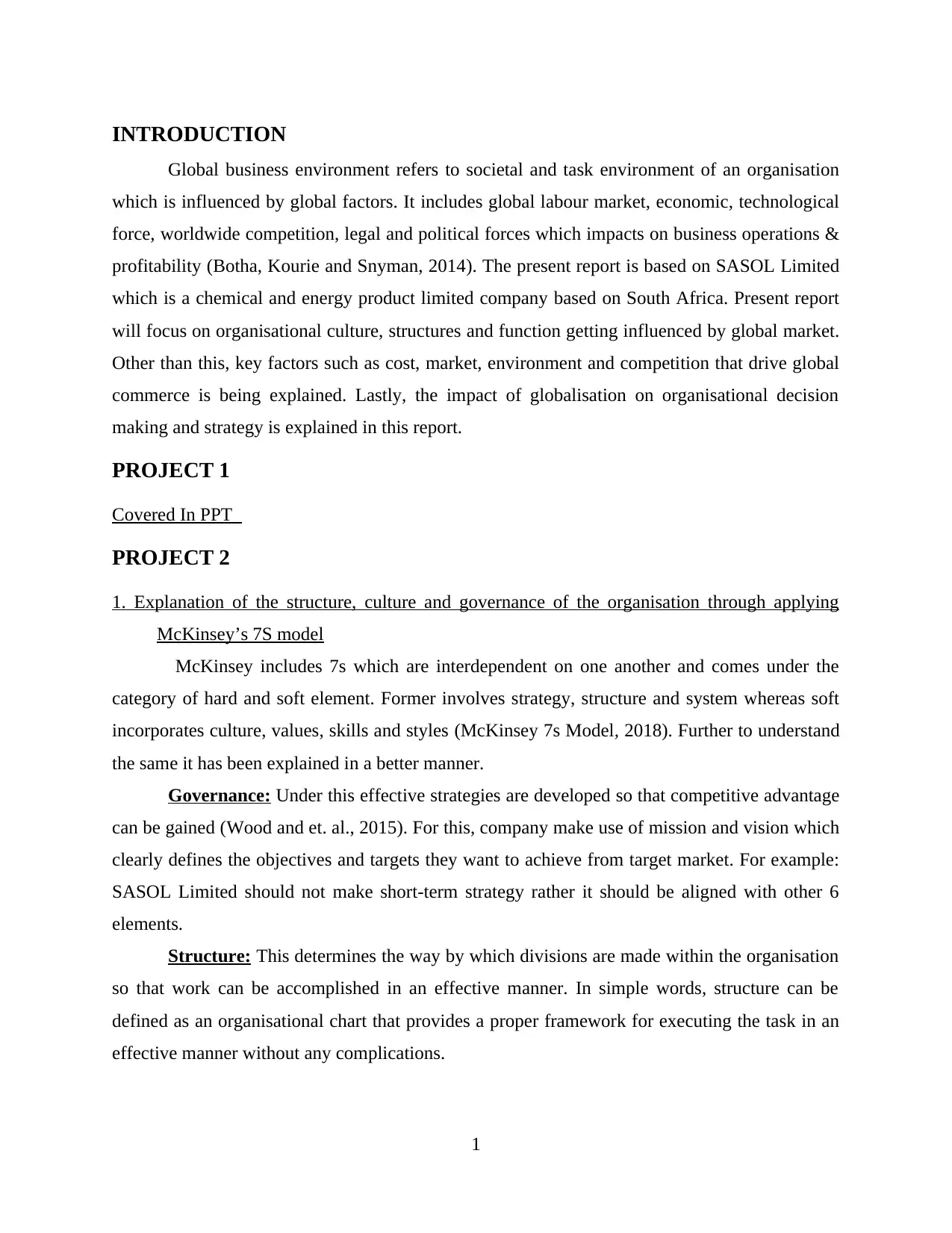
INTRODUCTION
Global business environment refers to societal and task environment of an organisation
which is influenced by global factors. It includes global labour market, economic, technological
force, worldwide competition, legal and political forces which impacts on business operations &
profitability (Botha, Kourie and Snyman, 2014). The present report is based on SASOL Limited
which is a chemical and energy product limited company based on South Africa. Present report
will focus on organisational culture, structures and function getting influenced by global market.
Other than this, key factors such as cost, market, environment and competition that drive global
commerce is being explained. Lastly, the impact of globalisation on organisational decision
making and strategy is explained in this report.
PROJECT 1
Covered In PPT
PROJECT 2
1. Explanation of the structure, culture and governance of the organisation through applying
McKinsey’s 7S model
McKinsey includes 7s which are interdependent on one another and comes under the
category of hard and soft element. Former involves strategy, structure and system whereas soft
incorporates culture, values, skills and styles (McKinsey 7s Model, 2018). Further to understand
the same it has been explained in a better manner.
Governance: Under this effective strategies are developed so that competitive advantage
can be gained (Wood and et. al., 2015). For this, company make use of mission and vision which
clearly defines the objectives and targets they want to achieve from target market. For example:
SASOL Limited should not make short-term strategy rather it should be aligned with other 6
elements.
Structure: This determines the way by which divisions are made within the organisation
so that work can be accomplished in an effective manner. In simple words, structure can be
defined as an organisational chart that provides a proper framework for executing the task in an
effective manner without any complications.
1
Global business environment refers to societal and task environment of an organisation
which is influenced by global factors. It includes global labour market, economic, technological
force, worldwide competition, legal and political forces which impacts on business operations &
profitability (Botha, Kourie and Snyman, 2014). The present report is based on SASOL Limited
which is a chemical and energy product limited company based on South Africa. Present report
will focus on organisational culture, structures and function getting influenced by global market.
Other than this, key factors such as cost, market, environment and competition that drive global
commerce is being explained. Lastly, the impact of globalisation on organisational decision
making and strategy is explained in this report.
PROJECT 1
Covered In PPT
PROJECT 2
1. Explanation of the structure, culture and governance of the organisation through applying
McKinsey’s 7S model
McKinsey includes 7s which are interdependent on one another and comes under the
category of hard and soft element. Former involves strategy, structure and system whereas soft
incorporates culture, values, skills and styles (McKinsey 7s Model, 2018). Further to understand
the same it has been explained in a better manner.
Governance: Under this effective strategies are developed so that competitive advantage
can be gained (Wood and et. al., 2015). For this, company make use of mission and vision which
clearly defines the objectives and targets they want to achieve from target market. For example:
SASOL Limited should not make short-term strategy rather it should be aligned with other 6
elements.
Structure: This determines the way by which divisions are made within the organisation
so that work can be accomplished in an effective manner. In simple words, structure can be
defined as an organisational chart that provides a proper framework for executing the task in an
effective manner without any complications.
1
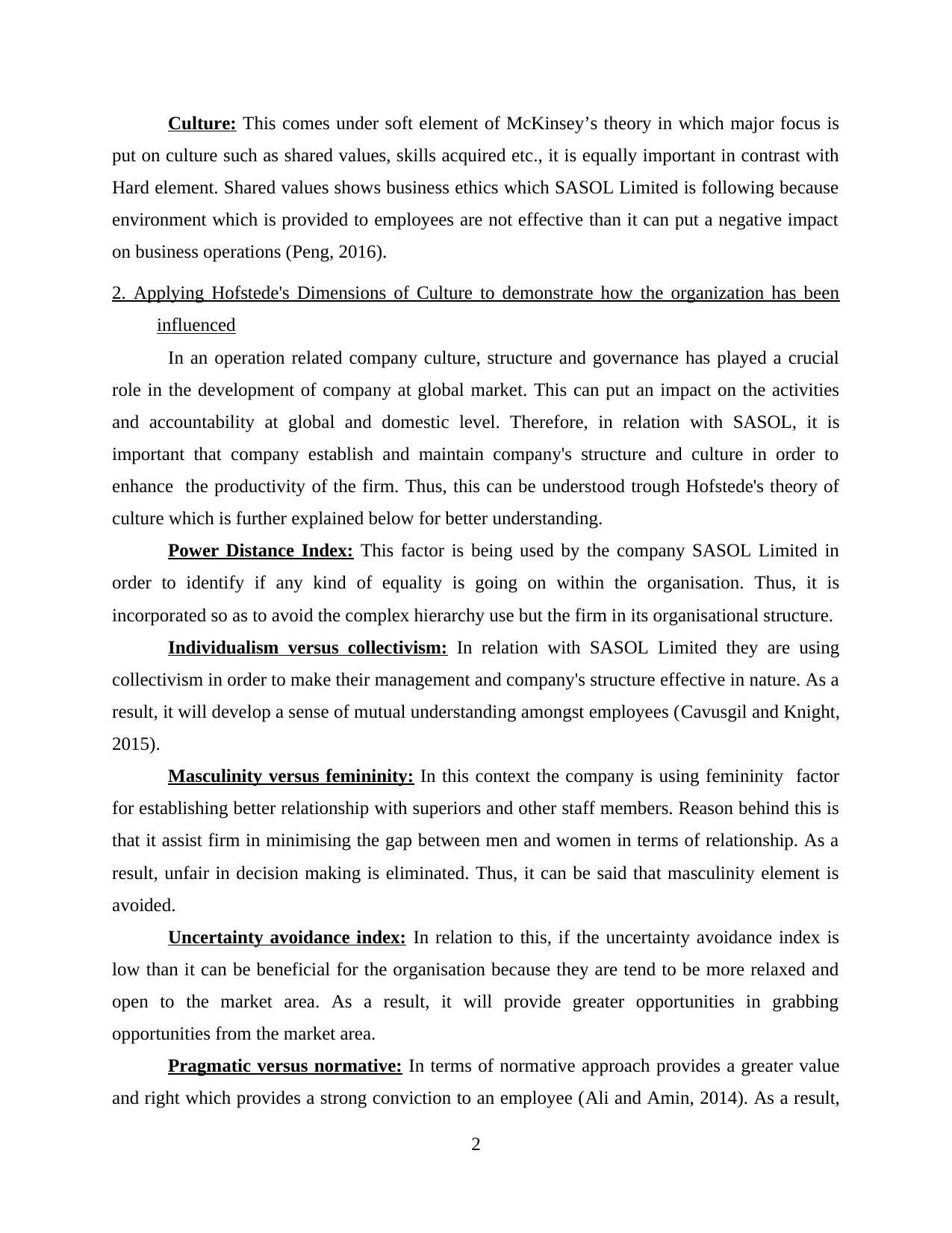
Culture: This comes under soft element of McKinsey’s theory in which major focus is
put on culture such as shared values, skills acquired etc., it is equally important in contrast with
Hard element. Shared values shows business ethics which SASOL Limited is following because
environment which is provided to employees are not effective than it can put a negative impact
on business operations (Peng, 2016).
2. Applying Hofstede's Dimensions of Culture to demonstrate how the organization has been
influenced
In an operation related company culture, structure and governance has played a crucial
role in the development of company at global market. This can put an impact on the activities
and accountability at global and domestic level. Therefore, in relation with SASOL, it is
important that company establish and maintain company's structure and culture in order to
enhance the productivity of the firm. Thus, this can be understood trough Hofstede's theory of
culture which is further explained below for better understanding.
Power Distance Index: This factor is being used by the company SASOL Limited in
order to identify if any kind of equality is going on within the organisation. Thus, it is
incorporated so as to avoid the complex hierarchy use but the firm in its organisational structure.
Individualism versus collectivism: In relation with SASOL Limited they are using
collectivism in order to make their management and company's structure effective in nature. As a
result, it will develop a sense of mutual understanding amongst employees (Cavusgil and Knight,
2015).
Masculinity versus femininity: In this context the company is using femininity factor
for establishing better relationship with superiors and other staff members. Reason behind this is
that it assist firm in minimising the gap between men and women in terms of relationship. As a
result, unfair in decision making is eliminated. Thus, it can be said that masculinity element is
avoided.
Uncertainty avoidance index: In relation to this, if the uncertainty avoidance index is
low than it can be beneficial for the organisation because they are tend to be more relaxed and
open to the market area. As a result, it will provide greater opportunities in grabbing
opportunities from the market area.
Pragmatic versus normative: In terms of normative approach provides a greater value
and right which provides a strong conviction to an employee (Ali and Amin, 2014). As a result,
2
put on culture such as shared values, skills acquired etc., it is equally important in contrast with
Hard element. Shared values shows business ethics which SASOL Limited is following because
environment which is provided to employees are not effective than it can put a negative impact
on business operations (Peng, 2016).
2. Applying Hofstede's Dimensions of Culture to demonstrate how the organization has been
influenced
In an operation related company culture, structure and governance has played a crucial
role in the development of company at global market. This can put an impact on the activities
and accountability at global and domestic level. Therefore, in relation with SASOL, it is
important that company establish and maintain company's structure and culture in order to
enhance the productivity of the firm. Thus, this can be understood trough Hofstede's theory of
culture which is further explained below for better understanding.
Power Distance Index: This factor is being used by the company SASOL Limited in
order to identify if any kind of equality is going on within the organisation. Thus, it is
incorporated so as to avoid the complex hierarchy use but the firm in its organisational structure.
Individualism versus collectivism: In relation with SASOL Limited they are using
collectivism in order to make their management and company's structure effective in nature. As a
result, it will develop a sense of mutual understanding amongst employees (Cavusgil and Knight,
2015).
Masculinity versus femininity: In this context the company is using femininity factor
for establishing better relationship with superiors and other staff members. Reason behind this is
that it assist firm in minimising the gap between men and women in terms of relationship. As a
result, unfair in decision making is eliminated. Thus, it can be said that masculinity element is
avoided.
Uncertainty avoidance index: In relation to this, if the uncertainty avoidance index is
low than it can be beneficial for the organisation because they are tend to be more relaxed and
open to the market area. As a result, it will provide greater opportunities in grabbing
opportunities from the market area.
Pragmatic versus normative: In terms of normative approach provides a greater value
and right which provides a strong conviction to an employee (Ali and Amin, 2014). As a result,
2
Secure Best Marks with AI Grader
Need help grading? Try our AI Grader for instant feedback on your assignments.
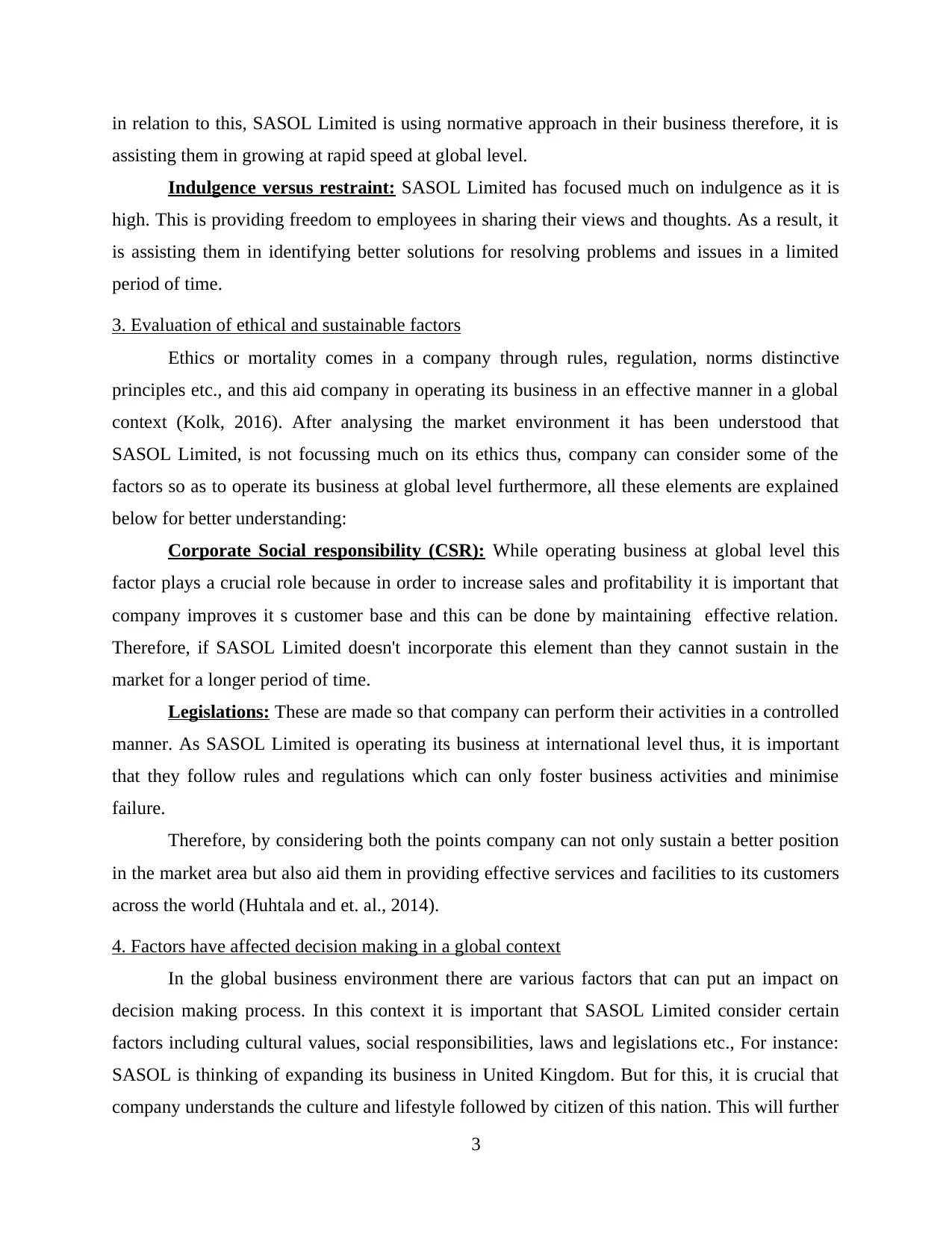
in relation to this, SASOL Limited is using normative approach in their business therefore, it is
assisting them in growing at rapid speed at global level.
Indulgence versus restraint: SASOL Limited has focused much on indulgence as it is
high. This is providing freedom to employees in sharing their views and thoughts. As a result, it
is assisting them in identifying better solutions for resolving problems and issues in a limited
period of time.
3. Evaluation of ethical and sustainable factors
Ethics or mortality comes in a company through rules, regulation, norms distinctive
principles etc., and this aid company in operating its business in an effective manner in a global
context (Kolk, 2016). After analysing the market environment it has been understood that
SASOL Limited, is not focussing much on its ethics thus, company can consider some of the
factors so as to operate its business at global level furthermore, all these elements are explained
below for better understanding:
Corporate Social responsibility (CSR): While operating business at global level this
factor plays a crucial role because in order to increase sales and profitability it is important that
company improves it s customer base and this can be done by maintaining effective relation.
Therefore, if SASOL Limited doesn't incorporate this element than they cannot sustain in the
market for a longer period of time.
Legislations: These are made so that company can perform their activities in a controlled
manner. As SASOL Limited is operating its business at international level thus, it is important
that they follow rules and regulations which can only foster business activities and minimise
failure.
Therefore, by considering both the points company can not only sustain a better position
in the market area but also aid them in providing effective services and facilities to its customers
across the world (Huhtala and et. al., 2014).
4. Factors have affected decision making in a global context
In the global business environment there are various factors that can put an impact on
decision making process. In this context it is important that SASOL Limited consider certain
factors including cultural values, social responsibilities, laws and legislations etc., For instance:
SASOL is thinking of expanding its business in United Kingdom. But for this, it is crucial that
company understands the culture and lifestyle followed by citizen of this nation. This will further
3
assisting them in growing at rapid speed at global level.
Indulgence versus restraint: SASOL Limited has focused much on indulgence as it is
high. This is providing freedom to employees in sharing their views and thoughts. As a result, it
is assisting them in identifying better solutions for resolving problems and issues in a limited
period of time.
3. Evaluation of ethical and sustainable factors
Ethics or mortality comes in a company through rules, regulation, norms distinctive
principles etc., and this aid company in operating its business in an effective manner in a global
context (Kolk, 2016). After analysing the market environment it has been understood that
SASOL Limited, is not focussing much on its ethics thus, company can consider some of the
factors so as to operate its business at global level furthermore, all these elements are explained
below for better understanding:
Corporate Social responsibility (CSR): While operating business at global level this
factor plays a crucial role because in order to increase sales and profitability it is important that
company improves it s customer base and this can be done by maintaining effective relation.
Therefore, if SASOL Limited doesn't incorporate this element than they cannot sustain in the
market for a longer period of time.
Legislations: These are made so that company can perform their activities in a controlled
manner. As SASOL Limited is operating its business at international level thus, it is important
that they follow rules and regulations which can only foster business activities and minimise
failure.
Therefore, by considering both the points company can not only sustain a better position
in the market area but also aid them in providing effective services and facilities to its customers
across the world (Huhtala and et. al., 2014).
4. Factors have affected decision making in a global context
In the global business environment there are various factors that can put an impact on
decision making process. In this context it is important that SASOL Limited consider certain
factors including cultural values, social responsibilities, laws and legislations etc., For instance:
SASOL is thinking of expanding its business in United Kingdom. But for this, it is crucial that
company understands the culture and lifestyle followed by citizen of this nation. This will further
3
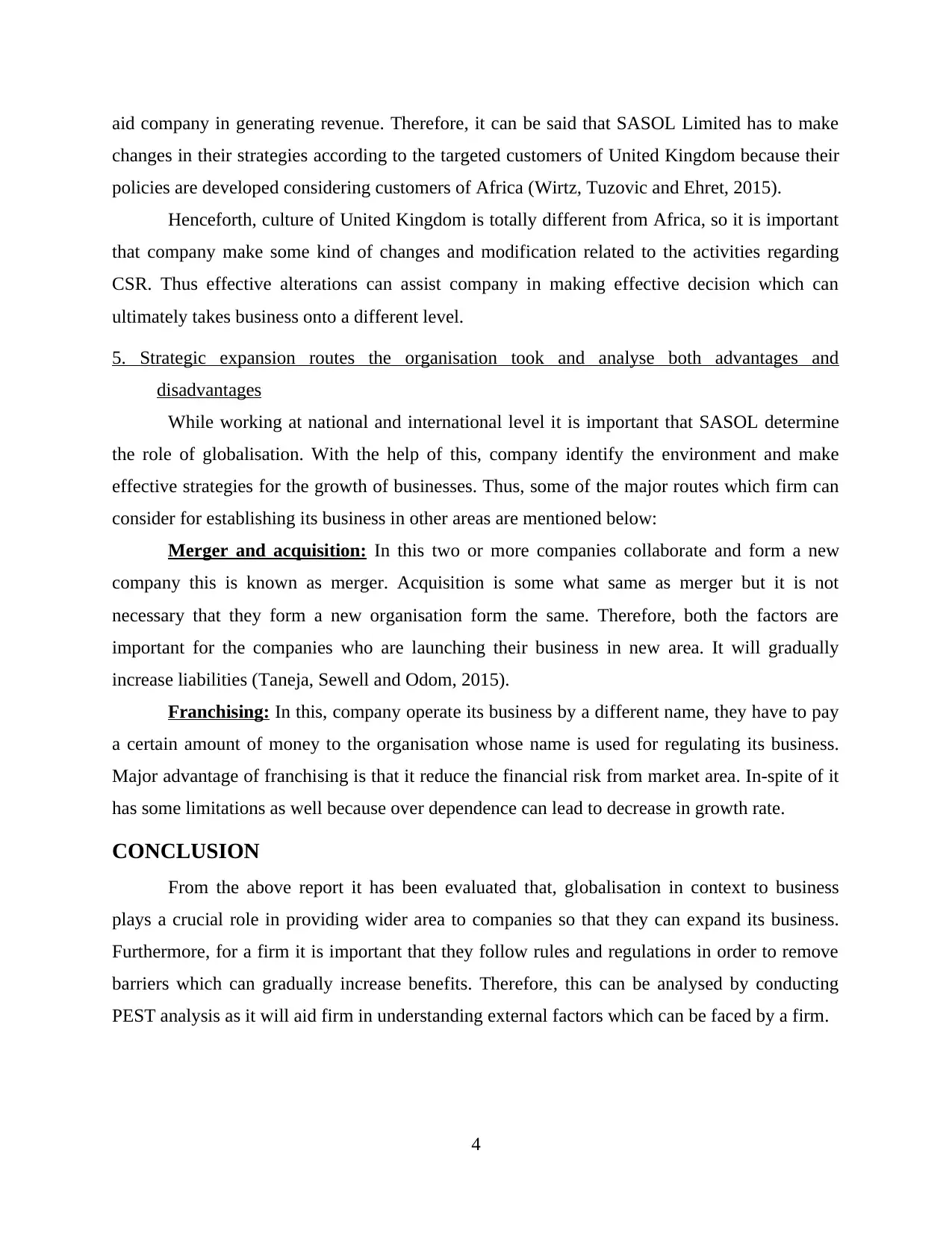
aid company in generating revenue. Therefore, it can be said that SASOL Limited has to make
changes in their strategies according to the targeted customers of United Kingdom because their
policies are developed considering customers of Africa (Wirtz, Tuzovic and Ehret, 2015).
Henceforth, culture of United Kingdom is totally different from Africa, so it is important
that company make some kind of changes and modification related to the activities regarding
CSR. Thus effective alterations can assist company in making effective decision which can
ultimately takes business onto a different level.
5. Strategic expansion routes the organisation took and analyse both advantages and
disadvantages
While working at national and international level it is important that SASOL determine
the role of globalisation. With the help of this, company identify the environment and make
effective strategies for the growth of businesses. Thus, some of the major routes which firm can
consider for establishing its business in other areas are mentioned below:
Merger and acquisition: In this two or more companies collaborate and form a new
company this is known as merger. Acquisition is some what same as merger but it is not
necessary that they form a new organisation form the same. Therefore, both the factors are
important for the companies who are launching their business in new area. It will gradually
increase liabilities (Taneja, Sewell and Odom, 2015).
Franchising: In this, company operate its business by a different name, they have to pay
a certain amount of money to the organisation whose name is used for regulating its business.
Major advantage of franchising is that it reduce the financial risk from market area. In-spite of it
has some limitations as well because over dependence can lead to decrease in growth rate.
CONCLUSION
From the above report it has been evaluated that, globalisation in context to business
plays a crucial role in providing wider area to companies so that they can expand its business.
Furthermore, for a firm it is important that they follow rules and regulations in order to remove
barriers which can gradually increase benefits. Therefore, this can be analysed by conducting
PEST analysis as it will aid firm in understanding external factors which can be faced by a firm.
4
changes in their strategies according to the targeted customers of United Kingdom because their
policies are developed considering customers of Africa (Wirtz, Tuzovic and Ehret, 2015).
Henceforth, culture of United Kingdom is totally different from Africa, so it is important
that company make some kind of changes and modification related to the activities regarding
CSR. Thus effective alterations can assist company in making effective decision which can
ultimately takes business onto a different level.
5. Strategic expansion routes the organisation took and analyse both advantages and
disadvantages
While working at national and international level it is important that SASOL determine
the role of globalisation. With the help of this, company identify the environment and make
effective strategies for the growth of businesses. Thus, some of the major routes which firm can
consider for establishing its business in other areas are mentioned below:
Merger and acquisition: In this two or more companies collaborate and form a new
company this is known as merger. Acquisition is some what same as merger but it is not
necessary that they form a new organisation form the same. Therefore, both the factors are
important for the companies who are launching their business in new area. It will gradually
increase liabilities (Taneja, Sewell and Odom, 2015).
Franchising: In this, company operate its business by a different name, they have to pay
a certain amount of money to the organisation whose name is used for regulating its business.
Major advantage of franchising is that it reduce the financial risk from market area. In-spite of it
has some limitations as well because over dependence can lead to decrease in growth rate.
CONCLUSION
From the above report it has been evaluated that, globalisation in context to business
plays a crucial role in providing wider area to companies so that they can expand its business.
Furthermore, for a firm it is important that they follow rules and regulations in order to remove
barriers which can gradually increase benefits. Therefore, this can be analysed by conducting
PEST analysis as it will aid firm in understanding external factors which can be faced by a firm.
4
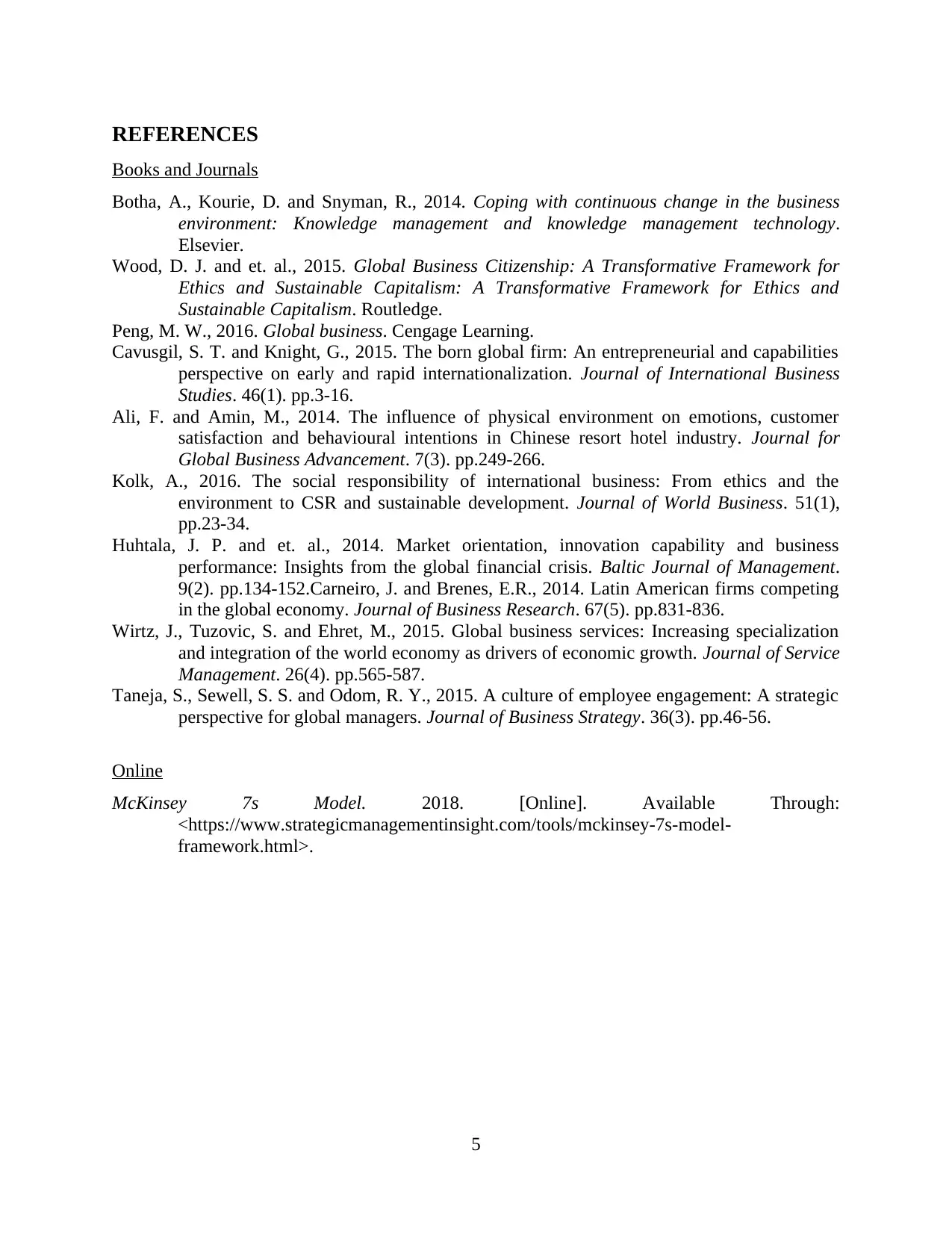
REFERENCES
Books and Journals
Botha, A., Kourie, D. and Snyman, R., 2014. Coping with continuous change in the business
environment: Knowledge management and knowledge management technology.
Elsevier.
Wood, D. J. and et. al., 2015. Global Business Citizenship: A Transformative Framework for
Ethics and Sustainable Capitalism: A Transformative Framework for Ethics and
Sustainable Capitalism. Routledge.
Peng, M. W., 2016. Global business. Cengage Learning.
Cavusgil, S. T. and Knight, G., 2015. The born global firm: An entrepreneurial and capabilities
perspective on early and rapid internationalization. Journal of International Business
Studies. 46(1). pp.3-16.
Ali, F. and Amin, M., 2014. The influence of physical environment on emotions, customer
satisfaction and behavioural intentions in Chinese resort hotel industry. Journal for
Global Business Advancement. 7(3). pp.249-266.
Kolk, A., 2016. The social responsibility of international business: From ethics and the
environment to CSR and sustainable development. Journal of World Business. 51(1),
pp.23-34.
Huhtala, J. P. and et. al., 2014. Market orientation, innovation capability and business
performance: Insights from the global financial crisis. Baltic Journal of Management.
9(2). pp.134-152.Carneiro, J. and Brenes, E.R., 2014. Latin American firms competing
in the global economy. Journal of Business Research. 67(5). pp.831-836.
Wirtz, J., Tuzovic, S. and Ehret, M., 2015. Global business services: Increasing specialization
and integration of the world economy as drivers of economic growth. Journal of Service
Management. 26(4). pp.565-587.
Taneja, S., Sewell, S. S. and Odom, R. Y., 2015. A culture of employee engagement: A strategic
perspective for global managers. Journal of Business Strategy. 36(3). pp.46-56.
Online
McKinsey 7s Model. 2018. [Online]. Available Through:
<https://www.strategicmanagementinsight.com/tools/mckinsey-7s-model-
framework.html>.
5
Books and Journals
Botha, A., Kourie, D. and Snyman, R., 2014. Coping with continuous change in the business
environment: Knowledge management and knowledge management technology.
Elsevier.
Wood, D. J. and et. al., 2015. Global Business Citizenship: A Transformative Framework for
Ethics and Sustainable Capitalism: A Transformative Framework for Ethics and
Sustainable Capitalism. Routledge.
Peng, M. W., 2016. Global business. Cengage Learning.
Cavusgil, S. T. and Knight, G., 2015. The born global firm: An entrepreneurial and capabilities
perspective on early and rapid internationalization. Journal of International Business
Studies. 46(1). pp.3-16.
Ali, F. and Amin, M., 2014. The influence of physical environment on emotions, customer
satisfaction and behavioural intentions in Chinese resort hotel industry. Journal for
Global Business Advancement. 7(3). pp.249-266.
Kolk, A., 2016. The social responsibility of international business: From ethics and the
environment to CSR and sustainable development. Journal of World Business. 51(1),
pp.23-34.
Huhtala, J. P. and et. al., 2014. Market orientation, innovation capability and business
performance: Insights from the global financial crisis. Baltic Journal of Management.
9(2). pp.134-152.Carneiro, J. and Brenes, E.R., 2014. Latin American firms competing
in the global economy. Journal of Business Research. 67(5). pp.831-836.
Wirtz, J., Tuzovic, S. and Ehret, M., 2015. Global business services: Increasing specialization
and integration of the world economy as drivers of economic growth. Journal of Service
Management. 26(4). pp.565-587.
Taneja, S., Sewell, S. S. and Odom, R. Y., 2015. A culture of employee engagement: A strategic
perspective for global managers. Journal of Business Strategy. 36(3). pp.46-56.
Online
McKinsey 7s Model. 2018. [Online]. Available Through:
<https://www.strategicmanagementinsight.com/tools/mckinsey-7s-model-
framework.html>.
5
1 out of 7
Related Documents
Your All-in-One AI-Powered Toolkit for Academic Success.
+13062052269
info@desklib.com
Available 24*7 on WhatsApp / Email
![[object Object]](/_next/static/media/star-bottom.7253800d.svg)
Unlock your academic potential
© 2024 | Zucol Services PVT LTD | All rights reserved.





